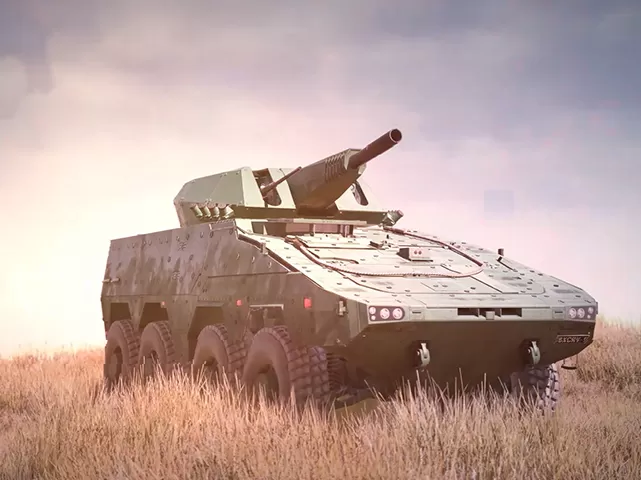
Swift, Safe, and Deadly
Meet “Crossbow”, an innovative mortar system reshaping battlefield tactics with rapid, accurate fire from the security of armored vehicles.
The mortar infantry squad rides through the heart of a dangerous battlefield. As they navigate their armored vehicle through rugged terrain, an urgent fire mission appears from the command unit, calling for immediate assistance. The squad leader swiftly receives the target information on his tablet. With expert precision, he aligns to it using a smart automated system. With the press of a button, the mortar round is fired.
All of this happens in under 60 seconds.
This rapid response is made possible by the “Crossbow” system, a turreted mortar system mounted on armored vehicles, developed by Elbit Systems' Land.
Rapid Response, Anywhere
"This system was created to meet the needs of the next generation," says Ofek, the mortar business unit manager. After serving for a decade as a senior artillery officer in the Israeli army, he joined the company to contribute his expertise in the field.
Unlike traditional mortar teams, which are confined to secure areas after setting up fortified positions, the Crossbow allows infantry mortar squads to operate with newfound freedom. "In the past, our teams were exposed to enemy fire while operating vehicle-mounted mortars," explains Ofek. "We developed an automated system that keeps the crew safe inside the vehicle, fully protected."
This advanced system not only protects the crew but also extends the range and accuracy of their firepower. "We’ve increased the operational range to more than 10 kilometers, compared to the traditional 7-8 kilometers. This enhancement is vital for both direct and indirect fire support in modern combat scenarios, particularly in urban environments where close-quarter engagements are common," Ofek said.
Modular and Diverse System
One of the key advantages of the Crossbow system is its versatility. It can fire a wide range of NATO-approved munitions, including those not produced by Elbit. "Many competing systems require specific ammunition," says Dani, another key player in the company's mortars line of business. "Our system can handle diverse types of munitions including our "Iron Sting" Guided Mortar Munition (GMM), which is an important advantage in the field."
The system’s ability to load and fire from any angle without repositioning greatly enhances the rate of fire and operational efficiency. "Unlike competing products that require the operator to align the barrel to a specific position, load it, and only then fire, the Crossbow can load and fire from any position," Dani reassures.
Beyond its firing capabilities, the Crossbow system integrates various defensive and offensive modules. "The system is modular," says Ofek. "We can add a coaxial machine gun, laser defense systems, observation posts, and smoke screens. This adaptability not only boosts the system’s firepower but also enhances the overall protection and operational capability of the crew."
The potential of the Crossbow system has already garnered international interest. "We recently signed a contract with the European company GDELS," Dani reveals. "This marks an important milestone for us."
As the system continues to evolve, it aims to set new standards in battlefield technology. "We are in the process of developing prototypes for further integration on various platforms," Dani adds. "The future holds immense possibilities for enhancing both the safety and effectiveness of our military forces."
The content of the article does not constitute business or financial information about Elbit Systems Ltd. (the "Company") and is not intended to be a basis for making investment decisions in the Company's securities. In order to obtain business or financial information about the Company, please refer to the reports and filings that the Company regularly publishes on the website of the U.S Securities and Exchange Commission (EDGAR) and on the notification system of the Tel Aviv Stock Exchange (Maya).
The article may contain forward-looking statements such as estimates, forecasts, estimates, plans, etc. that refer to future events that are considered forward-looking information as defined under the securities laws of Israel and the United States. There is no certainty that such information will be realized, in whole or in part, and the actual result may differ from what was presented in the article, among other things due to its dependence on external factors that are not under the control of the Company and that cannot be evaluated in advance. The forward-looking statements are based on the Company's estimates at the time of publication, and the Company has no obligation to update or correct this data.

